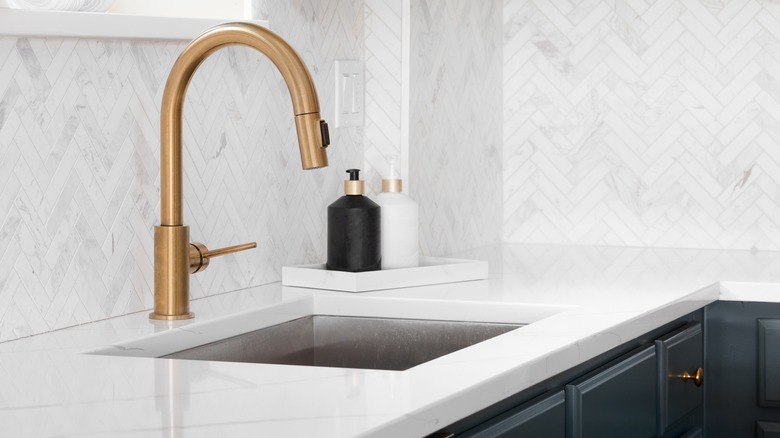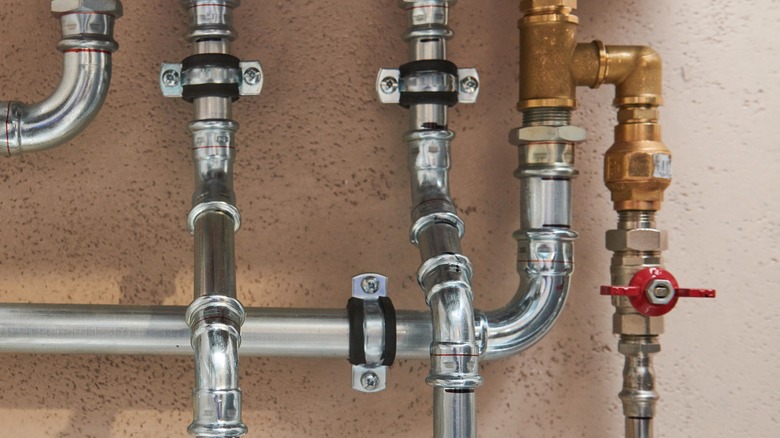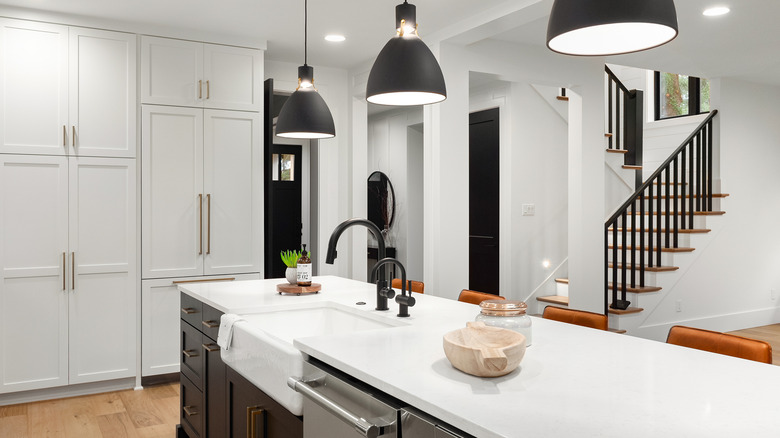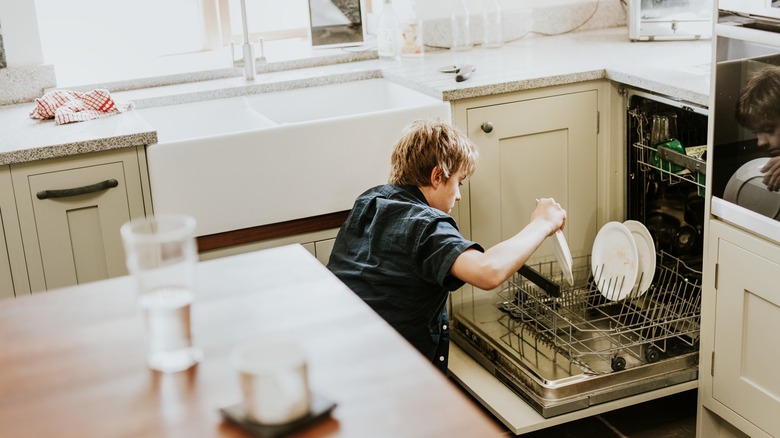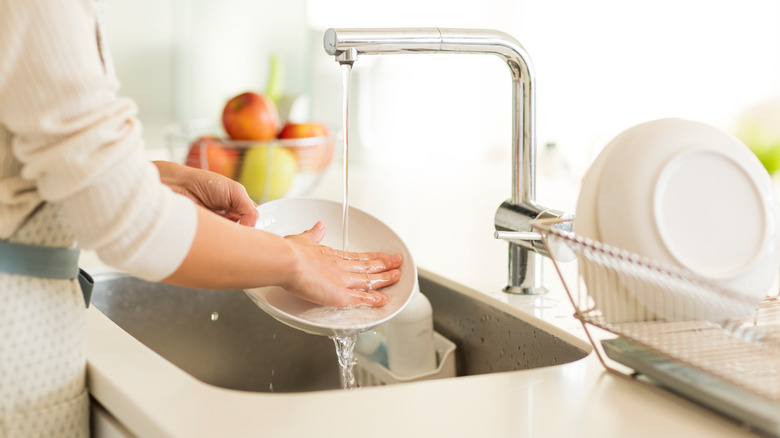5 Tips For Finding The Perfect Placement For Your Kitchen Sink
There's a surprising amount of time spent at the kitchen sink, so deciding where the perfect placement is can be a bit challenging. Kitchen sinks handle a lot within the home, including cleaning the dishes, filling pots with water for pasta, and providing a refreshing drink of water. It's these details you'll want to consider when trying to decide where the sink should go in the kitchen. Everyone's lifestyle is unique to their family, and how you use the kitchen for cooking will affect where you put it. For example, if you don't do a lot of cooking, maybe washing dishes isn't a big part of your life.
Additionally, you'll want to use the kitchen work triangle rules to help you find the optimal spot. The kitchen work triangle is a set of rules designers use to help them find the best location for the three major kitchen items (via Cliq Studios). Each point on the triangle represents the refrigerator, the sink, and the cooktop. The legs of the triangle shouldn't be longer than 9 feet and no shorter than 4 feet. While these aren't mandatory, they're guidelines that can help you on your journey to perfect sink placement.
1. Where is the plumbing?
According to Reliability Home Services, plumbing is the most distinguishing detail that will determine where a kitchen sink should (and can) go. Sometimes there are locations within your kitchen that would be impossible to add a sink. For example, there might be an HVAC pipe behind the wall that you can't move. Also, depending on the codes in your area, you might not be allowed to put plumbing lines on exterior walls. However, if you're already doing a complete kitchen remodel, you can put the kitchen sink almost anywhere you want as long as you're willing to increase your budget to account for the extra work the plumber will need to do.
Alternatively, it's best to put the sink where plumbing lines already exist if you're looking to save on cost. This doesn't mean you have to keep it in the same spot. For example, sometimes, there are bathrooms on the other side of a wall, and a plumber can more easily add a sink next to those existing plumbing lines.
2. Sink with a view
When there are windows in a kitchen, it's very common for the kitchen sink to be placed under one of those windows. It's a great way to provide natural light while working at the sink, while also giving you something to look at while washing the dishes. So when you're considering moving the sink to a new location, you'll want to think about the view. While a nice view of the backyard or your flower garden is an excellent option, it's not the only one, notes Tiffany Leigh Design.
Those with small kids might want a view of the living room so they can keep an eye on playing kids while prepping for dinner. Additionally, if you often have guests over for dinner, you might want to stay in the conversation while working in the kitchen. So maybe the view you're more interested in is the faces of friends and family instead of the veggie garden you're working hard to grow.
3. Light up the sink
If you're lucky enough to have a big window over your kitchen sink, it's easy to see what you're doing on a sunny day (via Tiffany Leigh Design). Unfortunately, if it's raining or after dark, it can be hard to see if those dishes are actually clean without proper lighting. So while thinking about the best place for the sink, don't forget about adequate lighting. Again, this includes a window, but you'll also want to consider supplemental lighting for when the sun isn't out or when it's hiding behind the clouds. Or, if you've decided not to put the sink under a window at all, you now won't have that natural light to brighten the area.
Recessed lighting above the sink can work great, but task lighting such as pendant lights or even trendy track lighting will bring the light source closer to what you're working on in the sink. This will make tasks such as cleaning veggies and washing dishes much more manageable.
4. Think about its neighbors
As mentioned above, the best kitchen sink placement has a lot to do with what is around it. The kitchen work triangle talks about the cooktop and the refrigerator, but according to CRD Design Build, you also want to think about kitchen work zones.
After dinner, clean-up can be made a lot easier if the sink is close to the trash and recycling. When you need to scrape off plates before rinsing them off, you won't want to have to walk across the kitchen. Similarly, after rinsing off the plates, it can be annoying to put them in the dishwasher if it's not nearby. For the optimal kitchen, experience places the trash on one side of the sink and the dishwasher on the other. If the kitchen sink is on an island, you can still get away with this by placing the dishwasher on the wall across the pathway.
It's also essential to consider workstations and counter space in relation to the kitchen sink. Those who do a lot of food prep might find it annoying if the sink doesn't have enough counter space on either side.
5. Go for more than one
Families are busy, and sometimes one sink isn't enough to cover everything you need to do within the kitchen. For example, have you ever tried to refill the Keurig machine when the dishes weren't done last night? It's annoying to pull out all the dishes to fill it up. Maybe you've even resorted to taking it to the bathroom, so you didn't have to mess with the dishes.
If you're having difficulty finding the perfect placement for your kitchen sink, it might mean you need two (via MR Direct). When homeowners opt for two sinks in their kitchen, it's very popular to put one on the island and the other on a perimeter wall. This setup means you have one sink for food prep and cooking, while the other can be dedicated to dirty dishes.
Of course, this means double the sinks and faucets, and more plumbing lines will need to be added. All this extra work and material will bump up the budget, so be sure to keep that in mind.
